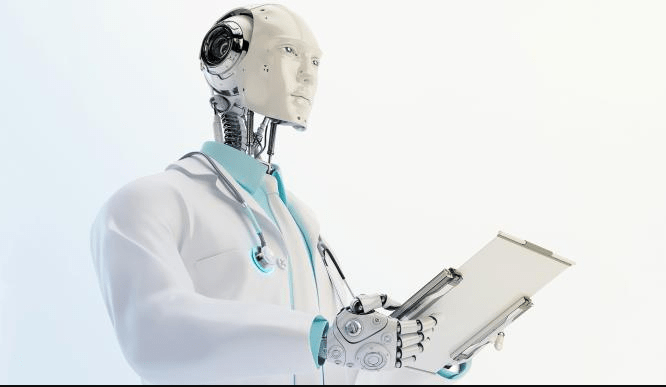From construction and farming to banking and transportation, robots are seeping into every aspect of our lives. And healthcare is no exception. Oristep Consulting, a market research and analytics company, puts the future of healthcare robotics under the spotlight. Companies offering healthcare app development services are playing a crucial role in this transformation. Over 200 tech companies are already building specialized robotic devices for an array of healthcare facilities. And the market for medical robots is expected to surge to $46.24 billion by 2022, up from $6.36 billion in 2016.

With this in mind, let’s now explore how hospitals find success with different types of robots and see whether there’s a flip side to the story.
Robots for every clinical function
Medical robots have just recently started picking up steam, but their diversity is already making the mind boggle. From microscopic robots performing tasks inside a human body to personal exoskeletons and disinfectants, robots bring tangible value to both physicians and patients.
To lay bare the success of healthcare robotics, let’s look at some common types of robots and outline a couple of use cases.
Courier robots
As their name suggests, courier, or transportation, robots are set to move equipment, medication, and meals from one place to another — inside and outside clinical settings.
To wit, TUG is a smart robot that uses a built-in hospital map to transport scheduled and on-demand critical deliveries, such as tissue and blood samples, from point A to point B.
Designed by Aethon, this cutting-edge gear never gets distracted, and it takes less time for it to complete the delivery as compared to a human. In addition, TUG can replace three full-time employees by working two shifts 7 days a week; meanwhile, it costs less than one full-time worker.
Among the 130 different hospitals already using TUGs is the UCSF Medical Center in San Francisco. The organization purchased 25 robots to cross the distance of 600,000 square feet. Josh Adler, UCSF Chief Medical Officer, says the center is pleased with TUGs: “They’re so much more reliable for delivering things where they need to be on time. That allows our staff to focus on things that people do so well — caring, decision-making, supporting.”
Surgical robots
These remote-controlled robots enhance minimally invasive procedures performed by doctors. And as 3DHD technology is getting better by leaps and bounds, surgical robots are becoming apter to conduct complex operations, including enhanced natural stereo visualization coupled with augmented reality.
Da Vinci is probably the most known surgical robot. It assists doctors in gynecologic, cardiac, colorectal, head and neck, thoracic and urologic surgeries, and the US Food and Drug Administration (FDA) is continuing to approve its further use.
Despite the high implementation cost, da Vinci robots are touted as a wise investment. Advocates of robotic surgery claim da Vinci is good at delicate procedures, like radical prostatectomy for prostate cancer.
“Robotic surgery can remove more cancerous tissue with less disruption of adjacent nerve endings than other methods, helping to reduce cancer recurrence and retain sexual function,” they say. So it stands to reason that 85% of patients who need such an operation opt for medical centers where robotic surgery is an option.
Rehabilitation and therapeutic robots
Rehabilitation robots aimed at delivering meaningful restorative therapy come in two types:
- Assistive robotic manipulators, powered wheelchairs, and exoskeletons are built to help stroke or spinal cord injury patients. These devices substitute for lost limbs and let paralyzed people walk.
- Therapy robots are designed to accelerate rehabilitation by allowing patients to practice body movements. For example, MIT-Manus has increased therapists’ productivity and proved its value in rehabilitating stroke victims who had problems with moving their arms.
Companion robots, or social partners — considered a subcategory of therapeutic robots — enhance the cure of patients with disabilities and mental health issues. These AI-enabled devices are usually equipped with sensors, cameras, and microphones to interact with their owners and remind them to take pills.
Physicians actively use CosmoBot to treat developmentally and learning disabled children. Enhanced by gestural sensors and voice recognition, the robot motivates patients to interact with the environment more while learning new things and having fun.
CosmoBot is purported to bring favorable outcomes, and there’s a proof it does. Researchers from AnthroTronix, Inc. analyzed the robot’s interaction with patients with cerebral palsy at Mount Washington Pediatric Hospital in Cheverly to find out it’s able to engage children and assist healthcare providers with physical therapy intervention for upper extremity movements.
Robot adoption: Weighing up the pros and cons
With an increasing health IT market share and a variety of applications, medical robots have a bright future. But before you jump into healthcare robotics with both feet, you need to review a number of factors. Here are the possible pros and cons.
How hospitals can benefit from robots
Considering the fact robots don’t need rest, they’re more productive than humans and can automate a great deal of clinical routine.
Legendary Silicon Valley investor and futurist Vinod Khosla predicts that robotic technologies have the potential to assume physicians’ duties, including diagnostic, prescription, and patient monitoring procedures. And this is about 80% of what physicians do on a daily basis. According to Khosla, the remaining 20% of work will be amplified, allowing doctors to focus on practical approaches to patient-centered care.

Empowered by AI and machine learning, robots are also able to collect and analyze vast amounts of data, providing physicians with meaningful insights into a patient’s conditions, as well as contributing to predictive medicine. Precision and accuracy are robots’ forte too: they’re unemotional, don’t experience fatigue, and have no attention gaps. As a result, they’re less prone to error as compared to humans.
What can hurdle robot adoption
One of the major cons of medical robots is their extremely high implementation cost (to purchase da Vinci, you would need to allocate $2 million) and substantial maintenance fees. So hospitals have to conduct a cost-benefit analysis to make certain they’ll get the desirable outcomes without breaking the proverbial bank. Although wide robot adoption leads to enhanced productivity, there’s still the risk of significant job cuts. Conversely, robots’ advocates argue these machines are mainly built to assist clinicians rather than replace them. Another roadblock that may get in the way is the system interoperability issue. Robots should communicate well with other software installed on the hospital premises, and reaching this goal is never a walk in the park. Thankfully, healthcare policy makers are introducing relevant standards and giving practical recommendations, thus helping software vendors to create highly-interoperable robotics solutions.
Final thoughts
However conservative the healthcare industry might have seemed, its focus on technology-driven innovations has recently been pretty much in evidence. And the adoption of robots that come in all shapes and sizes fits naturally into this trend. Despite some cons, robots have the potential to significantly contribute to delivering value-based, patient-centered care. Right now, hospitals around the world are redefining care delivery with the help of these smart assistants, while engaging patients, improving efficiency, and streamlining clinical processes.









